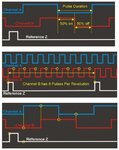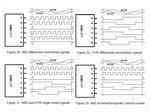phatcreators
Full Member level 5
What are Resolver, Encoder & Tachometer ?
Differences between these Feedback techniques ?
When to employ these ?
thanks
Differences between these Feedback techniques ?
When to employ these ?
thanks
Follow along with the video below to see how to install our site as a web app on your home screen.
Note: This feature may not be available in some browsers.
Resolver (electrical), a type of rotary electrical transformer used for measuring degrees of rotation
A rotary encoder converts rotary position to an analog (e.g., analog quadrature) or digital (e.g., digital quadrature, 32-bit parallel, or USB) electronic signal.
A linear encoder similarly converts linear position to an electronic signal.
Such encoders can be either absolute or incremental. The signal from an absolute encoder gives an unambiguous position within the travel range without requiring knowledge of any previous position. The signal from an incremental encoder is cyclical, thus ambiguous, and requires counting of cycles to maintain absolute position within the travel range. Both can provide the same accuracy, but the absolute encoder is more robust to interruptions in transducer signal.
A tachometer (revolution-counter, Tach, rev-counter, RPM gauge) is an instrument measuring the rotation speed of a shaft or disk, as in a motor or other machine.
Modern tachometers are actually rotary incremental encoders which indicate position, speed, and direction of rotation.
Tachometer in older systems is usually small dc- or ac-generator indicating rpm.
Incremental Encoder
is an encoder that produces pulses in proportion to distance moved or rotated. Incremental encoders can also have a marker pulse Z, Z NOT (, ) once per revolution to provide a position reference. Avtron produces a full range of incremental rotary encoders.
Quadrature encoder
To determine which direction an encoder is revolving, encoders output quadrature signals: two streams of pulses, A & B, generated at 90° timing angles. (Also called A Quad B) A leading B indicates rotation in one direction; B leading A indicates the encoder is rotating in the opposite direction. Example: “A leads B with clockwise rotation as viewed from the encoder face on an M4 encoder.” Many encoders with quadrature outputs also have complementary outputs: A NOT and B NOT signals (, , , ).
Optical Encoder
typically uses a light source shining through, or reflecting off, an optical disk with lines or slots that interrupt the beam of light to an optical sensor. Electronics count the interruptions of the beam and generate the encoder’s output pulses.
Magnetic Encoder
Magnetic and magnetoresistive encoders typically use a magnetized rotor with north and south poles lined up around the perimeter of the disk. A magnetoresistive sensor detects the transitions, and these are the counts or pulses generated by the encoder. Magnetic encoders withstand dirt, dust, water, and temperature changes far better than optical encoders.
Tutorials Resolver Vs Encoder
Resolver vs Encoder
Application of Rotary Optical Encoders and Resolvers in Brushless Servo Motors
**broken link removed**
Encoders and Motor feedback systems
**broken link removed**
Position encoders
Position encoders
BML Magnetic Linear Encoder Systems
**broken link removed**



